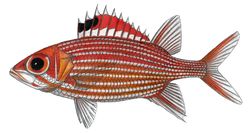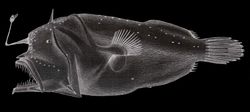About Me
 My name is Raymond Simpson. I am currently living in New Haven, Connecticut where I work at the Peabody Museum in Entomology. I have a wide range of interests but my passion for fishes goes back to when I was a kid. I have been studying fish and drawing fish since I was quite young copying photos from “Fishes of the World” and other books. My educational background is in biology and marine science. I have a Bachelors in Marine Science and a Masters in Ecology and Evolutionary Biology. I have been trained in cladistics, molecular systematics, and alpha taxonomy. I currently work with insects (Lepidoptera focus) but continue to illustrate fishes for this scientific purpose.
My name is Raymond Simpson. I am currently living in New Haven, Connecticut where I work at the Peabody Museum in Entomology. I have a wide range of interests but my passion for fishes goes back to when I was a kid. I have been studying fish and drawing fish since I was quite young copying photos from “Fishes of the World” and other books. My educational background is in biology and marine science. I have a Bachelors in Marine Science and a Masters in Ecology and Evolutionary Biology. I have been trained in cladistics, molecular systematics, and alpha taxonomy. I currently work with insects (Lepidoptera focus) but continue to illustrate fishes for this scientific purpose.
Follow me at Twitter (@ WAtlFish) and on iNaturalist (rayray)!
My Illustrations

 The personal side of this site is a showcase for my fish illustrations. I am entering into the field of scientific illustration, and I’m trying to establish myself in the sea of other artists out there. Most of the work on this site is mix of pencil drawings, both black-and-white and colored pencil. The species with distinctive color patterns are often rendered in colored pencil, while the drabber fishes are rendered in pencil. My work is done by hand and scanned into an image editor to make edges crisper and the background white. I have experience with PC-based illustrating programs, but prefer working by hand. I have also done fishes with pastel, but those are not online.
The personal side of this site is a showcase for my fish illustrations. I am entering into the field of scientific illustration, and I’m trying to establish myself in the sea of other artists out there. Most of the work on this site is mix of pencil drawings, both black-and-white and colored pencil. The species with distinctive color patterns are often rendered in colored pencil, while the drabber fishes are rendered in pencil. My work is done by hand and scanned into an image editor to make edges crisper and the background white. I have experience with PC-based illustrating programs, but prefer working by hand. I have also done fishes with pastel, but those are not online.
Many of my drawings are from the late 1990’s and 2000’s and are not up to the quality of the more recent illustrations as far as accuracy or rendering. Many will be used as placeholders until an improved version is drawn. Watermarks do not date older illustrations (pre-2011) but recent ones are fairly accurate.
Purpose of the Site
I hope that the site will be of use to anyone with an interest in fishes, and that it can serve a dual purpose of advertising my work and helping people with the identification of fishes from the western Atlantic. I am very familiar with the many internet taxonomic websites (WORMs, ToL, EoL, Wikispecies, etc.) and the sites focusing on fish taxonomy (Fishbase, Catalog of Fishes, Shorefishes of the Tropical Eastern Pacific, etc.), but the more “general” sites tend to lack detailed information on anything but the more common species. There is useful information scattered on these websites and in the literature, but the problem is that unless you have a university library available, a good half of the western Atlantic fauna (probably more like 60-70%) is poorly known. Images of these species are even more rare. This improves by the year but updates to the species pages on most online sites is quite slow.
So my goal is not only to have the widely known species represented, but also the mostly unknown groups that are buried in the primary literature and haven’t been photographed since. I hope to make my site as useful as Fishbase from on online perspective, but give the information content of the FAO Living Marine Resources guide for every species of fish in the W. Atlantic basin. This is a lofty goal, but I see this as a ongoing work in progress. I think the result will be a thorough regional guide to a fish fauna that will inspire other people to do the same with their region.
The Species Pages
I tried to make this as easy to navigate as possible; listing by taxonomic family and ordering species in that family alphabetically. Each species is grouped in drop-down menus that allow a person to browse families easily and quickly. When clicking the scientific/common name of the species, a species page will be displayed with information unique to that species:
1. On the top is the illustration with a zoom in box if you scroll over the image. All images are copyrighted and watermarked for security. The proper scientific name, describing author, and year described are shown.
2. “Identification” section displays meristic characters (fin rays, vertebrae, scale counts, etc.) and other diagnostic characters to define that species.
3. “Color” describe the range of color pattern variation.
4. “Size” gives a range of average size or a maximum known size for that species.
5. “Habitat” gives a general idea of the depth range, substrate, and miscellaneous habitat information.
6. “Range” is a verbal description of the range map for that species, which is also presented visually for some species.
7. Finally, “references” cites all literature/webpages that were used to compile the information contained in the species account.
8. “Other notes” provides additional taxonomic information, similar species diagnoses, or any other information not included in previous sections.
New species accounts and illustrations will be added as they become available. Thumbnails of new illustrations are displayed on the homepage, and new species accounts (with or without illustrations) are also displayed on the homepage. Species are added randomly, and some are only displaying species images and names. The full account will be finished in when I get around to them.
Any comments, corrections, or inquiries regarding illustrations should be directed to my email (see the Contact info).
Thank you for visiting!